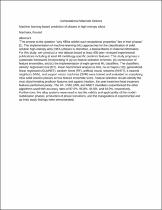JavaScript is disabled for your browser. Some features of this site may not work without it.
- ResearchSpace
- →
- Research Publications/Outputs
- →
- Journal Articles
- →
- View Item
| dc.contributor.author |
Machaka, Ronald

|
|
| dc.date.accessioned | 2023-03-10T07:46:07Z | |
| dc.date.available | 2023-03-10T07:46:07Z | |
| dc.date.issued | 2021-02 | |
| dc.identifier.citation | Machaka, R. 2021. Machine learning-based prediction of phases in high-entropy alloys. <i>Computational Materials Science, 188.</i> http://hdl.handle.net/10204/12665 | en_ZA |
| dc.identifier.issn | 0927-0256 | |
| dc.identifier.issn | 1879-0801 | |
| dc.identifier.uri | https://doi.org/10.1016/j.commatsci.2020.110244 | |
| dc.identifier.uri | http://hdl.handle.net/10204/12665 | |
| dc.description.abstract | “The answer to the question “why HEAs exhibit such exceptional properties” lies in their phases” [1]. The implementation of machine learning (ML) approaches for the classification of solid solution high-entropy alloy (HEA) phases is, therefore, a topical theme in material informatics. For this study, we construct a new dataset based at least 430 peer-reviewed experimental publications including at least 40 metallurgy-specific predictor features. This study proposes a systematic framework incorporating of (a) six feature selection schemes, (b) construction of feature ensembles, and (c) the implementation of eight general ML classifiers. The classifiers, namely: regression tree (DT), linear discriminant analysis (LDA), na ve Bayes (NB), generalized linear regression (GLMNET), random forest (RF), artificial neural networks (NNET), k-nearest neighbors (kNN), and support vector machines (SVM) were trained and evaluated on classifying HEA solid solution phases across feature ensemble sizes. Feature selection results identify the most discriminating predictor features and against intuition, the post-treatment heat-treatment features performed poorly. The RF, SVM, kNN, and NNET classifiers outperformed the other algorithms used with accuracy rates of 97.5%, 95.8%, 94.5%, and 94.0%, respectively. Furthermore, five alloy systems were used to test the validity and applicability of the model - stabilization phases, production of phase transitions, and the triangulation of experimental and ab initio study findings were demonstrated. | en_US |
| dc.format | Abstract | en_US |
| dc.language.iso | en | en_US |
| dc.relation.uri | https://www.sciencedirect.com/science/article/pii/S0927025620307357 | en_US |
| dc.source | Computational Materials Science, 188 | en_US |
| dc.subject | High-entropy alloys | en_US |
| dc.subject | HEA | en_US |
| dc.subject | Machine learning | en_US |
| dc.subject | Phase prediction | en_US |
| dc.title | Machine learning-based prediction of phases in high-entropy alloys | en_US |
| dc.type | Article | en_US |
| dc.description.pages | 9 | en_US |
| dc.description.note | © 2020 Elsevier B.V. All rights reserved. Due to copyright restrictions, the attached PDF file only contains the abstract of the full text item. For access to the full text item, please consult the publisher's website: https://www.sciencedirect.com/science/article/pii/S0927025620307357 | en_US |
| dc.description.cluster | Manufacturing | en_US |
| dc.description.impactarea | Powder Metallurgy Technologies | en_US |
| dc.identifier.apacitation | Machaka, R. (2021). Machine learning-based prediction of phases in high-entropy alloys. <i>Computational Materials Science, 188</i>, http://hdl.handle.net/10204/12665 | en_ZA |
| dc.identifier.chicagocitation | Machaka, Ronald "Machine learning-based prediction of phases in high-entropy alloys." <i>Computational Materials Science, 188</i> (2021) http://hdl.handle.net/10204/12665 | en_ZA |
| dc.identifier.vancouvercitation | Machaka R. Machine learning-based prediction of phases in high-entropy alloys. Computational Materials Science, 188. 2021; http://hdl.handle.net/10204/12665. | en_ZA |
| dc.identifier.ris | TY - Article AU - Machaka, Ronald AB - “The answer to the question “why HEAs exhibit such exceptional properties” lies in their phases” [1]. The implementation of machine learning (ML) approaches for the classification of solid solution high-entropy alloy (HEA) phases is, therefore, a topical theme in material informatics. For this study, we construct a new dataset based at least 430 peer-reviewed experimental publications including at least 40 metallurgy-specific predictor features. This study proposes a systematic framework incorporating of (a) six feature selection schemes, (b) construction of feature ensembles, and (c) the implementation of eight general ML classifiers. The classifiers, namely: regression tree (DT), linear discriminant analysis (LDA), na ve Bayes (NB), generalized linear regression (GLMNET), random forest (RF), artificial neural networks (NNET), k-nearest neighbors (kNN), and support vector machines (SVM) were trained and evaluated on classifying HEA solid solution phases across feature ensemble sizes. Feature selection results identify the most discriminating predictor features and against intuition, the post-treatment heat-treatment features performed poorly. The RF, SVM, kNN, and NNET classifiers outperformed the other algorithms used with accuracy rates of 97.5%, 95.8%, 94.5%, and 94.0%, respectively. Furthermore, five alloy systems were used to test the validity and applicability of the model - stabilization phases, production of phase transitions, and the triangulation of experimental and ab initio study findings were demonstrated. DA - 2021-02 DB - ResearchSpace DP - CSIR J1 - Computational Materials Science, 188 KW - High-entropy alloys KW - HEA KW - Machine learning KW - Phase prediction LK - https://researchspace.csir.co.za PY - 2021 SM - 0927-0256 SM - 1879-0801 T1 - Machine learning-based prediction of phases in high-entropy alloys TI - Machine learning-based prediction of phases in high-entropy alloys UR - http://hdl.handle.net/10204/12665 ER - | en_ZA |
| dc.identifier.worklist | 25479 | en_US |






